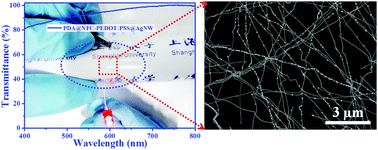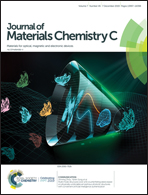Assembling polymeric silver nanowires for transparent conductive cellulose nanopaper†
Abstract
Transparent conductive cellulose nanopapers (TCCNPs) have been regarded as the most promising alternative to commercial polyethylene terephthalate-indium tin oxide (PET-ITO) films for the next-generation green flexible electronics and optoelectronics. Herein, a hierarchical TCCNP composed of conducting polymer (PEDOT:PSS) enhanced silver nanowire (AgNW) networks adsorbed on the polydopamine functionalized nanofibrillated cellulose (PDA@NFC) substrate was fabricated by a solution-based pressured-extrusion papermaking process. The PEDOT:PSS tightly decorated on the surfaces of AgNW networks provided more conductive electron pathways. As a result, an improved performance in TCCNP with a high conductivity of 7.32 Ohm sq−1 and a high optical transmittance of 92.56%@550 nm was ultimately achieved. More importantly, the TCCNP exhibited slight changes after being bent for 1000 cycling times and negligible changes after being peeled for 100 times. Furthermore, the soaking test demonstrated that the TCCNP with PEDOT:PSS additions displayed excellent chemical corrosion resistance. Significantly, the solution-processed TCCNP provides great potential as an easy disposable transparent conductive film (TCF) for superseding PET-ITO in the next-generation green flexible electronics and optoelectronics.



 Please wait while we load your content...
Please wait while we load your content...